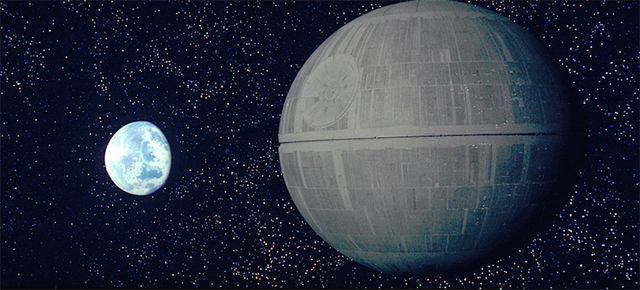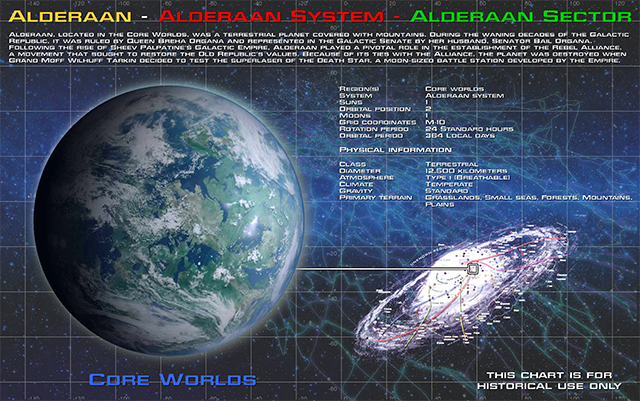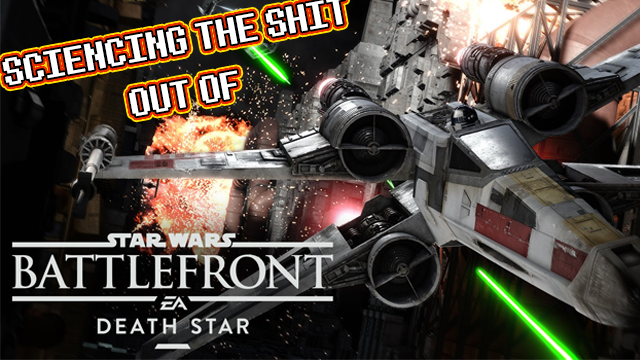By now you’ve played and replayed the iconic Battle of Yavin hundreds of times in the Battlefront DLC: Death Star, or you’ve certainly seen the first Star Wars movie, A New Hope, at least once. We know that eventually the famed Luke Skywalker navigates a trench in the surface of the Death Star and destroys the giant space station by firing a proton torpedo into a ventilation shaft causing a chain reaction that instantly destroyed the Imperial superweapon. In the upcoming movie Rogue One, we will get to learn more about the creation of this world destroyer and how the Rebel Alliance eventually gets its hands on the Death Star plans. But how does the weapon work in the first place?
In A New Hope, we see the Death Star fire its giant laser cannon to destroy the planet of Alderaan, the home of Princess Leia. But is that possible? Can a planet be destroyed in a single shot from a laser like that? What kind of power does the Death Star actually yield? I think those are very excellent questions begging to have the shit scienced out of them, so let’s takes a look, starting with the physics.

What does it take to blow up a planet?
For the most part, every planet is a sphere and Alderaan is certainly one of those spheres. It’s bound into this shape for a couple of reasons. First, we are working with a constant pull of mass to a center point. Although I’d love to talk about how matter starts spinning around other pieces of matter to eventually form planet, that will have to wait for another article. Secondly, we should know that when this happens one of two shapes form: a disc, like the rings of Saturn, or a sphere, like a planet. The gravity and spin of the mass is strong enough to smooth out its surface (from a macro perspective).
Since we are talking about a giant sphere floating in space, we can actually calculate how much energy it would take to counteract the binding energy of that type of object. This energy is usually measured in joules (J). Joules are notoriously difficult to put into practical terms because it’s a measure of work done, but I will attempt to help you out by using the banana constant. One banana weighs about .165 kg. Six bananas will weigh about a kilogram. A joule is about the same amount of energy that it takes to push six bananas one meter in one second. In more scientific terms, a joule is newtons (N) multiplied by meters (m) or watts (W) per second (s).
In order to break apart a sphere we have to create just as much outward energy as there is inward energy, this would cause the sphere to shatter instantly. This inward energy actually has a name; it’s called gravitational binding energy. And the calculation for this energy is U=3GM²/5R. G is equal to the gravitational constant. M is a mass of the sphere. And R is the radius of the sphere. Since we don’t have the all actual information for Alderaan, we will use Earth’s information for those. According to Wookieepedia, the planet was very much like Earth in a lots of ways. Its days are 24 hours and the surface is comprised of much of the same material. It’s highly likely that Alderaan’s gravitational constant and mass are the same. Wookieepedia also tells us that the diameter is slightly different at 12,500 km. But, to be fair, that’s only a couple hundred km off from Earth.
When you plug those numbers into the gravitational binding energy formula you get 248,700,000,000,000,000,000,000,000,000,000 (or 2.487 x 10³²) J. To give you some perspective, a nuclear bomb releases 4,184,000,000 J of energy. Even if you bound all the energy in all the nuclear bombs on Earth together (approximately 17,000 warheads), it would not even come close to the amount of energy that it would take to blow up Alderaan. It would be about 19 times less, to be precise. But there is another way.

Molten metal
An interesting fact about Earth is that the center of the planet is solid metal. Many other planets might have solid cores, but they aren’t always made of iron, like Earth. This allows for the planet to have a protective magnetic shield around it. We can assume that Alderaan is the same way since the surface and the life on Alderaan are so similar to Earth. This means that we know how to vaporize the core of the planet, and it might be simpler that you think.
The surface temperature that iron vaporizes is 3000 °C. However, in the center of Earth, we have a solid core sitting at about 5700 °C. The reason that it can sit at this temperature and not vaporize is because of the pressure that it’s under. Now imagine that the core is like a balloon. If we poke the balloon with a needle, releasing the pressure, the balloon explodes. Release the pressure of the core of Alderaan with… say… a giant laser, and then it will be as if millions of voices suddenly cried out in terror and were suddenly silenced.
That’s the way I science the shit out of the Death Star laser, but science isn’t science unless it’s tested and retested. What are your thoughts on the matter? Do you think you have a more accurate way for the Death Star laser to work? Let me know your thoughts in the comments, and may the Force be with you.







Published: Oct 14, 2016 06:52 am